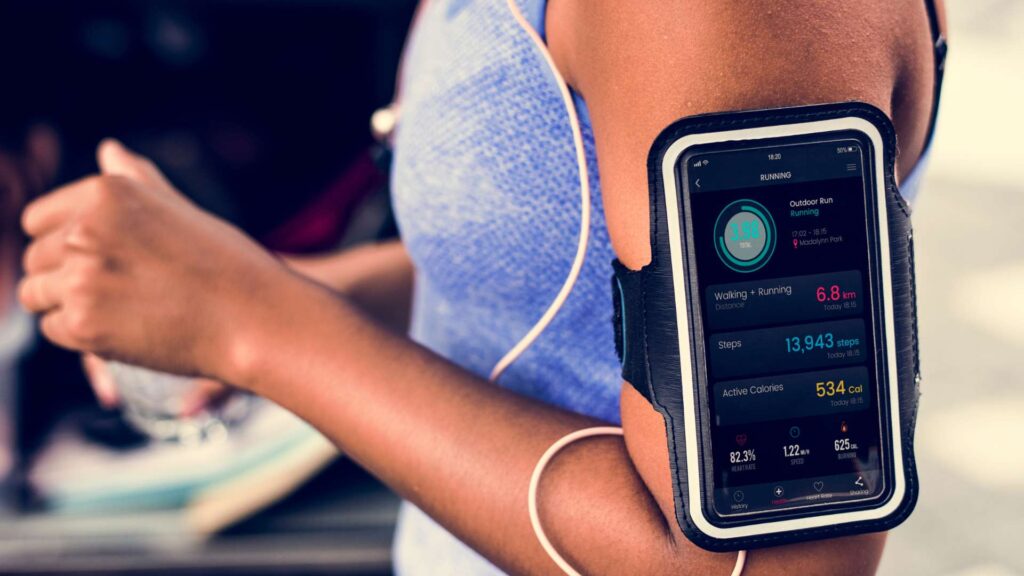Table of Contents
Wearable health technology is entering the American mainstream. These devices are assisting families across the nation in making wiser health choices. With healthcare costs escalating, people are seeking ways to remain healthier, avoid illness, and even cut spending, and wearable tech is here to deliver.
This can be an Apple Watch, which reminds you to stand at regular intervals, or a Fitbit to monitor your exercise regimes, or a continuous glucose monitor, which tracks blood sugar levels. Wearables provide a unique blend of inspiration, responsibility, and actionable data. Let’s explore using wearable devices to track, save, and improve your health.
Types of Wearable Health Devices
Today’s wearables go far beyond counting steps. The range of devices available means there’s something for nearly every health goal and family need.
1. Smartwatches
Smartwatches like the Apple Watch, Samsung Galaxy Watch, and Garmin models combine fitness tracking with productivity features. They measure activity, heart rate, and sometimes blood oxygen while delivering notifications and calls.
2. Fitness Trackers
Fitbit, WHOOP, and Xiaomi Mi Band focus on physical activity and tracking wellness. They’re lighter, often less expensive, and more kid-friendly.
3. Sleep Monitors
Some wearables, like the Oura Ring or specialized headbands, are built to track sleep patterns in detail. They monitor sleep stages, duration, and interruptions, offering insights into sleep quality.
4. Blood Glucose Sensors
For individuals with diabetes or prediabetes, continuous glucose monitors (CGMs) like Dexcom or FreeStyle Libre provide real-time blood sugar readings without finger pricks.
5. Specialized Health Monitors
These include devices for tracking heart rhythms (like KardiaMobile), posture (Upright Go), or even hydration (LVL). For families, choosing the right mix often means combining budget-friendly devices for kids with more advanced models for adults managing chronic health conditions.
Top Metrics Families Should Track
While wearables can measure dozens of things, some metrics provide the biggest payoff for family health.
- Steps & Daily Activity: The foundation of most wearable tracking. It promotes increased physical activity and a reduction in sedentary time.
- Sleep: Duration, consistency, and quality all impact mood, immunity, and performance, especially for kids.
- Heart Rate: Resting heart rate is a good indicator of overall cardiovascular health, while exercise heart rate zones help optimize workouts.
- Activity Minutes: Time spent in moderate to vigorous activity is crucial for heart health and weight management.
- Stress Levels: Some wearables use heart rate variability (HRV) to estimate stress and recommend breathing exercises.
- Calories Burned: Helps families balance food intake with energy expenditure.
- Blood Oxygen (SpO₂): Can help monitor respiratory health, especially during illness or high-altitude travel.
- Blood Glucose: Critical for individuals with diabetes, but increasingly valuable for those monitoring metabolic health.
When tracked consistently, these metrics can reveal trends before problems arise, empowering families to make changes early.
How Wearables Help You Save
Wearables aren’t just about improving your health; they can also save money over time.
1. Insurance Discounts
Many health insurance providers in the U.S. offer premium discounts for members who use fitness trackers and meet certain activity goals. For example:
- UnitedHealthcare’s Motion program provides up to $1,500/year in rewards.
- Some life insurance companies, like John Hancock, give lower rates for wearable data sharing.
2. Wellness Rewards
Employer wellness programs often provide gift cards, cash incentives, or health savings account (HSA) contributions for hitting activity targets tracked by wearables.
3. Lower Emergency and Chronic Care Costs
By identifying changes early, such as a spike in resting heart rate or irregular heart rhythms, wearables can help prevent costly ER visits or advanced disease treatment.
4. Smarter Spending on Fitness
Tracking at-home workouts can replace the need for costly gym memberships for some families while still providing motivation and progress tracking.
With Beem Health, wearable data can be integrated into virtual care plans, helping families qualify for incentives and making it easier to document healthy behaviors for insurance purposes.
Best Practices for Using Wearables With Kids
Children and teens can benefit significantly from wearable tracking, but using these devices responsibly is essential.
- Focus on Fun, Not Just Numbers: Make step goals a family game or a sibling challenge. Avoid overemphasis on weight or calories.
- Ensure Privacy: Choose devices with strong parental controls and data protection. Avoid apps that share data with third parties without consent.
- Age-Appropriate Goals: Kids’ activity needs differ from adults. The CDC recommends at least 60 minutes of daily physical activity for children.
- Encourage Positive Feedback: Celebrate milestones rather than criticizing missed goals.
- Teach Data Literacy: Help kids understand what the numbers mean and how habits affect them.
When handled well, wearables can build lifelong healthy habits and encourage kids to be more active and aware of their wellness.

Beyond Tracking: Acting on Health Data
The real benefits emerge when you act on the data you collect.
- Identify Trends: If your wearable indicates a drop in sleep quality, consider investigating possible causes, such as late-night screen time or stress.
- Adjust Workouts: Heart rate zones can help fine-tune exercise intensity for better results.
- Manage Chronic Conditions: Wearables can help people with diabetes, heart disease, or sleep apnea monitor their health daily and share updates with doctors.
- Prevent Illness: Subtle signs, like a slightly elevated resting heart rate, can sometimes indicate illness before symptoms appear.
- Share with Providers: Regularly export and share data with your healthcare team. With Beem Health, wearable data can be synced directly to your digital health record for provider review.
The Cost of Popular Wearables
Wearable devices vary widely in cost, and it’s essential to understand both upfront and ongoing expenses.
| Device | Price Range | Subscription Fees |
| Apple Watch Series 9 | $399–$799 | $9.99/mo for Apple Fitness+ (optional) |
| Fitbit Charge 6 | $159–$179 | $9.99/mo for Premium features |
| Garmin Venu 3 | $449 – $499 | No required subscription |
| WHOOP Strap 4.0 | $0 upfront | $30/mo membership |
| Oura Ring | $299 – $549 | $5.99/mo subscription |
Insurance incentives, reduced healthcare costs, and the potential to prevent expensive conditions can offset these seemingly high prices. Compared to the costs of routine urgent care visits or long-term chronic disease treatment, a wearable can be a worthwhile investment.
Limitations & Privacy Considerations
While wearables offer many benefits, they’re not perfect.
Accuracy
Device placement, skin tone, tattoos, and temperature can influence metrics. Use trends, not single readings, to guide decisions.
Privacy Risks
Sharing data with apps or insurers can have implications. Always read privacy policies, disable unnecessary data sharing, and choose devices with strong security protocols.
Realistic Expectations
Wearables are tools, not magic fixes. They provide information, but lifestyle change still requires effort, consistency, and sometimes professional guidance.
How Beem Health Syncs With Wearables
One of the challenges families face with wearable data is knowing what to do with it. Beem Health bridges that gap by integrating wearable information into your personalized care plan.
- Data Bundling: Beem combines data from multiple devices into one easy-to-read dashboard.
- Preventive Care Alerts: Providers can spot concerning trends early and recommend action.
- Rewards Integration: Syncing your device with Beem can help you qualify for wellness rewards and insurance discounts.
- Family Portals: Parents can securely monitor kids’ activity and health metrics in one place.
This approach transforms wearable tracking from a fun gadget feature into a powerful tool for proactive family health management.
Building a Connected Family Health Plan
Imagine a family where everyone’s daily activity, sleep, and stress levels are visible in one dashboard. The family collaborates on goals, turns health challenges into friendly competitions, and shares rewards.
With Beem Health, families can:
- Gamify Health Goals: Turn steps, active minutes, and sleep streaks into points redeemable for rewards.
- Support Chronic Care: Share data with providers for asthma, diabetes, or hypertension.
- Optimize Insurance: Use documented activity to qualify for premium reductions or HSA contributions.
- Prevent Issues Early: Catch concerning trends before they become costly emergencies.
By combining wearable data with digital chronic care and coaching tools, families can create a connected, sustainable health plan that saves money and builds healthier habits for the long run.
Conclusion
Using wearable devices to track, save, and improve your health is one of the most impactful applications of personal technology today. These devices continuously collect health data, provide insights, and often include gamification features to keep users engaged and motivated.
Beem Health offers accessible digital tools for those seeking help with their insurance policies and understanding their fine print. For any financial aid, you can check out Beem, a smart wallet app trusted by over 5 million Americans with features from cash advances to help with budgeting and tax calculations. In addition, Beem’s Everdraft™ lets you withdraw up to $1,000 instantly and with no checks. Download the app here.
FAQs About Using Wearable Devices to Track, Save, and Improve Your Health
Can my health insurance pay for a wearable device?
Some U.S. insurers and employers offer credits, reimbursements, or discounts on devices like the Apple Watch or the Fitbit if you meet specific health goals. Review your plan’s wellness program.
Are wearables safe for kids to use daily?
Yes, when used responsibly. Choose age-appropriate devices, enable privacy settings, and focus on positive motivation rather than constant performance pressure.
How does Beem Health work with wearables?
Beem Health securely syncs with most popular devices, integrates your data into preventive care plans, and helps you qualify for wellness rewards, all while keeping your family’s information private.














































